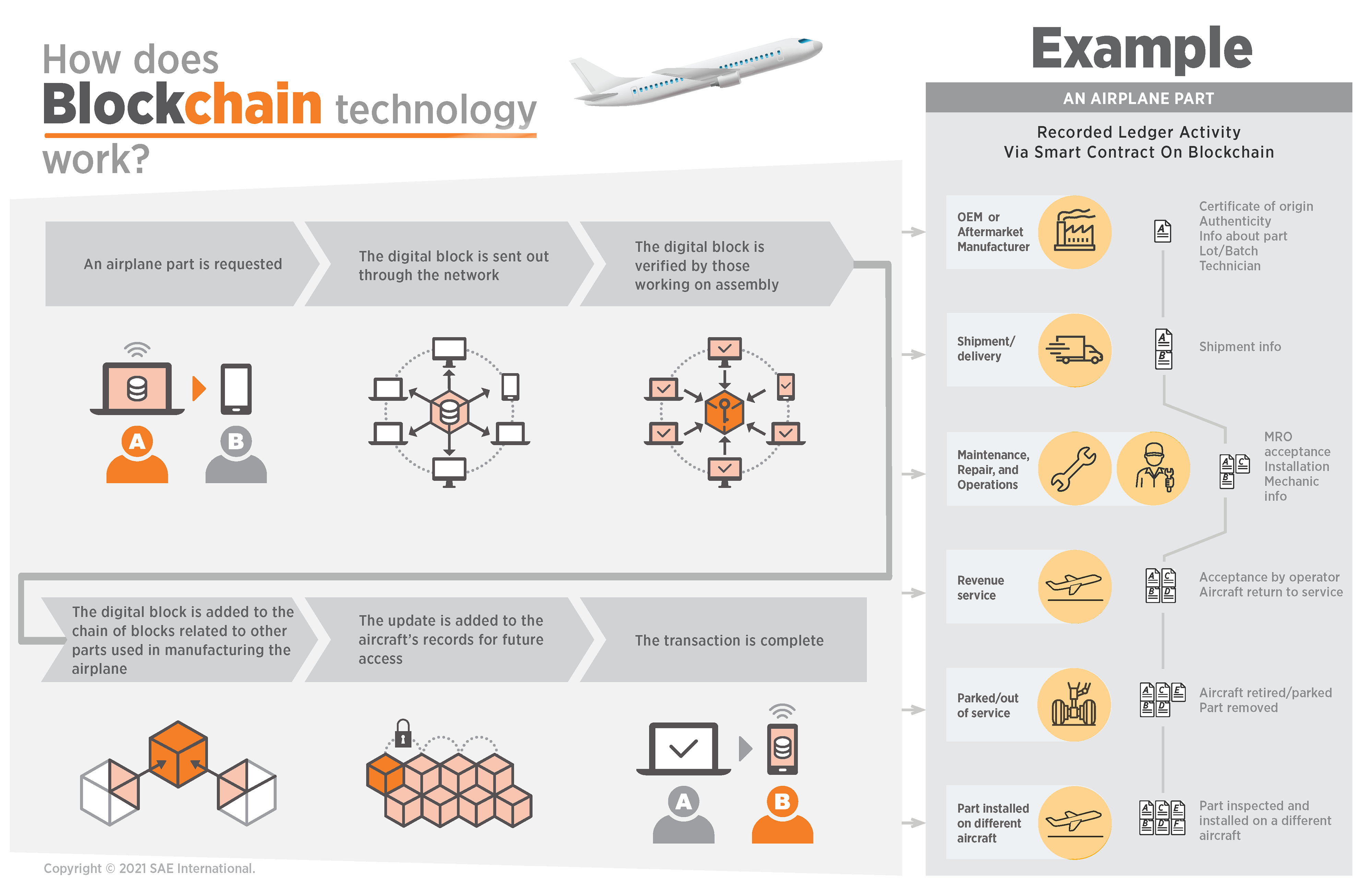Blockchain Can Save Lives
Posted: November 16, 2021
By Raman Venkatesh, Chief Operating Officer, SAE International
From the early days of the cryptocurrency, bitcoin has been steadily growing and now has become somewhat mainstream, with even a recently launched exchange-traded fund (in addition to several trading platforms and financial instruments). With this rapid growth, it should be no surprise that financial technology (“fintech”) became a pioneering application of blockchain; it is estimated that over 8 million Americans own bitcoin or other cryptocurrencies, making it the most popular application of blockchain technology.
But as we often see, the most popular uses of a technology are not always its best uses--that is, if you define “best” as saving human lives. The potential for blockchain’s inviolable transaction record has major applications in a world that is increasingly in need of reliable supply chains. The market for spurious or non-standard spare parts, from the disorganized dark markets to surprisingly well-organized global networks, is large and growing. This encompasses every industry imaginable, whether you are making airplanes with an over $100 million price tag or low-cost shaving razors with a $1 replacement blade. Wherever there is sizable value to be captured, there is incentive for after-market sales and service to develop, which ultimately atrophies into market segments with questionable parts and provenance.
Of course, the problem of a nick while shaving in the morning from a poorly manufactured blade isn’t quite the same as having a faulty angle-of-attack (AOA) sensor in a major commercial jet aircraft. Somewhere between this vast spectrum is passenger automobiles. If you spent over $75,000 on a car, then a $30 part vs. a $100 part could be the difference between being annoyed by frequent visits to the repair shop versus the smooth ride that you bought the car for in the first place. The contractual system of representations and warranties that exist in different markets attempts to assuage the customers but, in most cases, the assurance doesn’t quite replace the guarantee of a genuine part in the supply chain. Most engineers learn the concept of MTBF (mean time between failure) in various engineered systems and components. The world of quality assurance and product certification relies on MTBF in its various forms. The difference between a spurious part and a genuine part could mean, for example, 500 hours versus 5000 hours in MTBF – not noticeable immediately but damaging to promised endurance, at best, or life-threatening, at worst.
In the aerospace industry, this takes on a different dimension as many lives are involved. Every passenger plane (carrying 500, 50 or even 5 humans) takes off with the full expectation that every flight will land safely and with no inconvenience (via delays or troublesome in-flight experiences) to anyone. A trillion-dollar global market in commercial aviation relies on this simple assurance. Critical to this assurance is the expectation that the global MRO (maintenance, repair and overhaul) industry will have the right part at the right time replaced or serviced by the right technical talent to keep the tens of thousands of planes flying safely every day.
Blockchain can help make a quantum leap in improving the reliability of the entire aerospace and automotive supply chains. I am particularly referring to applications in after-market parts and provenance. Few things are more assuring than an unbroken, inviolable and universally auditable chain of records that track the lifecycle history of even a small part from its birth (manufacturing) till say, its 1000th use case.
This can also address the supply chain issues facing many industries today because if all entities and individuals know that no part of the supply chain can be tampered with, it will inspire confidence among all players to invest more into higher capacity production, distribution, and maintenance infrastructure. Streamlining of supply chains and the global orchestration required to ensure the right goods reach the right markets at the right time at the right cost are dependent on every element of the chain operating seamlessly with the elements that precede and follow it. Value leakages arising from spurious or poorly controlled components would practically disappear if the supply chain is built on a trust-worthy blockchain network. This will lead to increasing standardization, which yields substantial benefits in both economies of scale and reliability.
When we eliminate the need for humans or even computers to maintain disparate records of a component’s cradle-to-grave lifecycle, we bring in total transparency, in the form of an ever-present and ever-auditable real-time history of every component in the supply chain. What causes unscheduled repairs and even accidents are the weakest links in the entire supply chain. Whether that weakest link is a simple O-ring, an AOA sensor, an electrical battery component or the hundreds of hinges and rivets, lifecycle matters…a lot. Ensuring every component stays well within its MTBF window, and recognizing the geometrical progression risks of complex systems, is key to ensuring not a single life is lost. Knowing the entire lifecycle of each component (from ingredient BOM in manufacturing to its millionth use nearing its end) – all of which is available to all the stakeholders – provides a level of safety that is unmatched in the history of civil aviation and passenger automobiles.
At SAE International, we believe safety is non-negotiable and not a platform to compete on. Every automotive vehicle (whether it moves on land, water or in the air) must have unquestionable safety credentials. We have over 10,000 standards dedicated to safety across all mobility platforms. To us, blockchain is not just a ‘cool’ technology for fintech, but an essential one with farther reaching implications that promises heretofore unrealized potential for safety in the entire mobility sector.
Realizing that potential for the benefit of humanity is what we see as a real advancement in mobility knowledge and solutions. That should inspire all of us.

